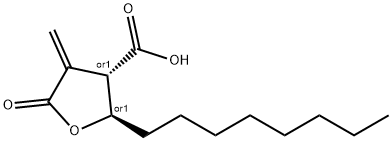191282-48-1
 191282-48-1 結(jié)構(gòu)式
191282-48-1 結(jié)構(gòu)式
基本信息
反-4-羧基-5-辛基-3-甲基-丁內(nèi)酯
脂肪酸合成酶FASN有效抑制劑(C75 TRANS)
反式-四氫-4-亞甲基-2-辛基-5-氧代-3-呋喃羧酸
C75 (trans)
C75 (racemic)
C 75 trC-75 trans-racemic
4-METHYLENE-2-OCTYL-5-OXOTETRAHYDROFURAN-3-CARBOXYLIC ACID
TETRAHYDRO-4-METHYLENE-2-OCTYL-5-OXO-3-FURANCARBOXYLIC ACID
(2R,3S)-4-METHYLIDENE-5-OXO-2-N-OCTYL-OXOLANE-3-CARBOXYLIC ACID
trans-4-Methylene-2-octyl-5-oxotetrahydrofuran-3-carboxylic acid
trans-Tetrahydro-4-Methylene-2-octyl-5-oxo-3-furancarboxylic Acid
(2S,3R)-4-methylene-2-octyl-5-oxotetrahydrofuran-3-carboxylic acid
物理化學(xué)性質(zhì)
| 報(bào)價日期 | 產(chǎn)品編號 | 產(chǎn)品名稱 | CAS號 | 包裝 | 價格 |
| 2024/11/08 | S8915 | 反-4-羧基-5-辛基-3-甲基-丁內(nèi)酯 C75 trans | 191282-48-1 | 5mg | 790元 |
| 2024/11/08 | S8915 | 反-4-羧基-5-辛基-3-甲基-丁內(nèi)酯 C75 trans | 191282-48-1 | 10mM(1mL in DMSO) | 1040.13元 |
| 2024/11/08 | S8915 | 反-4-羧基-5-辛基-3-甲基-丁內(nèi)酯 C75 trans | 191282-48-1 | 25mg | 4787.54元 |
常見問題列表
| Target | Value |
|
FASN
(clonogenic assay) | 35 μM |
|
FASN
(spheroid growth assay) | 50 μM |
trans-C75 ((±)-C75) inhibits PC3 cell growht with an IC 50 of 35 μM at 24 h. trans-C75 ((±)-C75)(10-50 μM) also reduces the growth of LNCaP spheroids in a concentration-dependent manner with an IC 50 of 50 μM. trans-C75 ((±)-C75) inhibits FAS activity and has a cytotoxic effect on tumor cell lines, without affecting food consumption. trans-C75 ((±)-C75) inhibits CPT1 and its administration produces anorexia, suggesting that central inhibition of CPT1 is essential for the anorectic effect of C75. The differential activity of C75 enantiomers may lead to the development of potential new specific drugs for cancer and obesity.
C75 blocks fasting-induced c-Fos expression in the arcuate nucleus (Arc), lateral hypothalamic area (LHA), and paraventricular nucleus (PVN) 10–24 h after i.p. injection. Intraperitoneal administration of C75 at 30 mg/kg body weight inhibits food intake of mice by ≥95% within 2 h after i.p. injection. C75-treated DIO mice has a 50% greater weight loss, and a 32.9% increased production of energy because of fatty acid oxidation. C75 treatment of rodent adipocytes and hepatocytes and human breast cancer cells increases fatty acid oxidation and ATP levels by increasing CPT-1 activity, even in the presence of elevated concentrations of malonyl-CoA.
